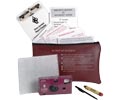Keller-Soft® DOT Compliance Audit & Policy Customizer®
Shows you how to prepare for and pass a DOT compliance audit.
Would your company make the grade if faced with a DOT compliance audit? This software makes it easy to find out!
Combining both auditing and policywriting capabilities, Customizer helps you identify and fix problem areas. It guides you through a self-audit and helps you review all six areas that DOT looks at. It also includes more than 30 templates for creating written policies.
The Keller-Soft® DOT Compliance Audit & Policy Customizer® features...
- A Video Introduction - Brief segment explains the two main software functions: auditing and policywriting.
- DOT Compliance Review Overview - Provides practical background information on the audit process, including definitions, how fitness ratings are determined, an explanation of violations, and a summary of how carriers are selected for review.
- DOT/Best Practice Audit Tools - Takes you through a detailed DOT audit and covers all the areas DOT reviews. Also allows you to audit other "best practice" areas.
- Customized Written Policies and Procedures - Just add some basic company-specific information, and you're done!
- Safety and Fitness Electronic Records System (SAFER) - Find out how to update information on your current Motor Carrier Profile and Motor Carrier Identification Report (MCS-150).
- Corrective Action Plans - Get a plan of action for correcting the violations you find.
Available in Single-User and Small Nework (2-10 Users) versions
Areas Covered and Component Parts
With the Keller-Soft® DOT Compliance Audit & Policy Customizer® you can prepare for and pass a DOT audit. The following is a full list of the audit areas and written policy templates included in the software.
Audit Areas:
- Accident/File Tracking
- Annual Vehicle Inspection
- Dispatch Operations
- Driver Logs - Passenger-Carrying Vehicles
- Driver Logs - Property-Carrying Vehicles
- Driver Orientation and Training
- Driver Qualification and Hiring
- Driver Safety Records
- Drugs and Alcohol
- Financial Responsibility
- Hazardous Materials
- Hours of Service - Passenger-Carrying Vehicles
- Hours of Service - Property-Carrying Vehicles
- Log Auditing - Passenger-Carrying Vehicles
- Log Auditing - Property-Carrying Vehicles
- Roadside Inspections
- Vehicle Maintenance
Written Policy Templates:
- Accident File/Tracking
- Accident Investigation
- Accident Review Policy
- Annual Vehicle Inspection
- Cargo Handling
- Defensive Driving
- Dispatch Operations
- Driver and Cargo Security
- Driver Customer Service
- Driver Employment Status
- Driver Logs - Passenger-Carrying Vehicles
- Driver Logs - Property-Carrying Vehicles
- Driver Orientation and Training
- Driver Performance Review
- Driver Qualification and Hiring (NEW)
- Driver Recruiting and Retention
- Driver Safety Records
- Driver/Employee Termination Policy
- Driver's Vehicle Inspections
- Drugs and Alcohol (Updated)
- Financial Responsibility
- Fire Prevention
- General Facility Safety
- General Yard and Facilities Security
- Hazardous Materials
- Hazardous Materials Security (HM-232)
- Hours of Service - Passenger-Carrying Vehicles
- Hours of Service - Property-Carrying Vehicles
- Injury Reporting and Return-to-Work Policy
- Internal Security (Updated)
- Log Auditing - Passenger-Carrying Vehicles
- Log Auditing - Property-Carrying Vehicles
- Multiple-employer Driver
- Personal Safety Policy
- Roadside Inspections
- Safety Guidelines and Procedures
- Sexual and Other Types of Harassment
- Vehicle Breakdown and Road Repair
- Vehicle Maintenance
Basic System Requirements
- Pentium III class or higher processor.
- Windows XP, Vista (32- and 64-bit), and Windows 7 (32- and 64-bit) operating system.
- Minimum 256 MB RAM to operate.
- CD-ROM drive
- Mouse required.
- Compatible printer.
- Video with resolution at least 800 x 600 (small fonts), 16-bit color.
- 60 MB available hard disk space.
Back to Top
Comprehensive Safety Analysis (CSA)
Training Main Page

















